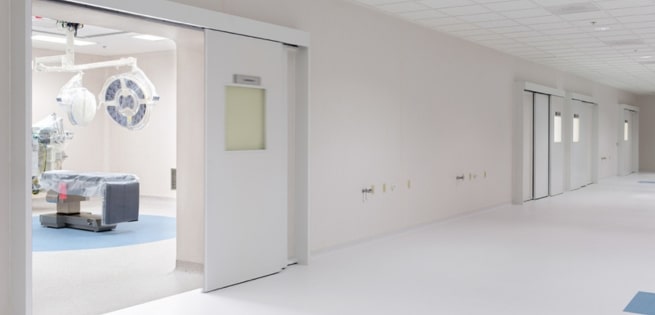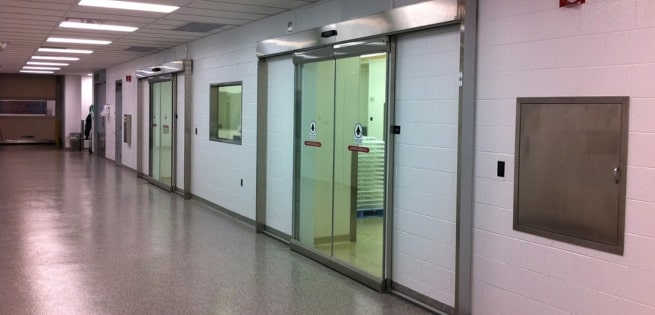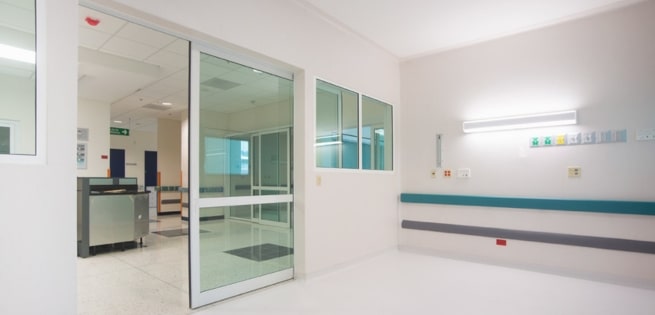How to choose the right cleanroom door?
November 23, 2023
As its name implies, a cleanroom is a room that needs to stay perfectly clean. Cleanrooms are built to exacting standards to keep out any undesired particulates. Part of these exacting standards include a very particular type of door, which will be the focus of our article. We’ll examine why cleanroom doors are so important, and which criteria to consider in selecting one.
What is a Cleanroom? What is a Cleanroom Door?

A cleanroom is built to house very sensitive activities that require an extremely low level of particulate matter in the air. This is because any particulates or debris could compromise the activities being done in the cleanroom. This typically involves very precise tasks relating to research, manufacturing, product development, and more.
Of course, since the door is the room’s main access point to the outside world, it serves a very special purpose. The door must be built in a way that allows people and equipment to access the room without compromising the integrity of the room itself. A door must keep any particulates out of the room, which requires a very specific level of manufacturing and installation. Below, we’ll examine all the factors you’ll need to consider in choosing a cleanroom door.
What are the right criteria for selecting appropriate doors for cleanrooms?

1: Know How Much Particulate Matter is Acceptable
Not all cleanrooms perform the same tasks. Before you select a cleanroom door, you need to know how tightly controlled the cleanroom environment will be. This requires a detailed knowledge of how much particulate matter is acceptable in the cleanroom. Essentially, the less particulate matter, the more extensive the door will need to be. This factor will guide all future decisions.
2: Quality Materials and Hardware
The first thing to look for in a cleanroom door is that it is made from quality materials. This includes the door itself and the materials affixing the door to the wall. The materials need to be strong and thick (recommended at least 60mm thick). This is not only to keep particulates out, but to ensure they can stand up to the rigors of an industrial environment and won’t break or bend. Typically, quality cleanroom doors are made from aluminum or stainless steel.
3: Tight Seal
If your cleanroom doesn’t form a tight seal when shut, then it will be useless. Many cleanroom doors are built with double-gasket design to ensure a tight shut. The door needs to form a tight seal at the top, bottom, and both sides. The seal needs to be completely airtight, which is why you need to buy a door that was specifically designed for this task.
4: Flat
This feature is often overlooked by buyers of cleanroom doors. It is important that the door has a flat surface, including where it connects to the wall and if there are any windows installed. This is because the door needs to be easy to wipe clean. If the door has any indentations, then it’s possible for dust to gather unnoticed. A flat door lessens this possibility and makes it much easier to wipe clean.
5: Locking
It’s important that the cleanroom door integrates into your security system as a whole. Due to the sensitive nature of what is being done in the room, you’ll likely want a door that works with your existing access privileges. For example, if your business operates on a key-card system, then you’ll want to be sure the door is compatible. Whatever locking mechanism you choose for the door, it’s most important that you provide access to the right people.
6: Open/Close Speed
Another factor to consider is how quickly you can open and close the door. Many cleanroom doors need to open for very short periods to ensure that no outside contaminants have the chance to enter. For this reason, many cleanroom doors are built with fast-sliding doors, which form a tight seal when shut. Alternatively, some doors operate automatically, which makes sure the door is never open for too long and always shuts properly.
7: Proper Installation
Finally, you need to be sure the door is properly installed so it’ll fit perfectly with the door frame, ensuring a tight fit when shut. Once again, this is why we recommend you contact a professional to handle this process. They’ll install the door so it blends seamlessly with your cleanroom and performs its intended function. After all, no matter the quality of the door, it won’t work properly if it’s installed improperly.
What are cleanroom doors made of?
There are many types of cleanroom doors, each with their own advantages and disadvantages. What’s most important is that you choose a style of door that is suited to the tasks being done in your cleanroom. Here’s a quick overview of the types of cleanroom doors:
- Sliding Doors: Sliding doors are uniquely suited to cleanroom environments. Their design allows them to sit flush against the wheel, forming a tight seal when shut. These doors are also able to slide open and shut quickly, which minimizes time spent exposed to the outside environment. However, these doors tend to be quite expensive to install, particularly if you want to give them “automatic” functionality.
- Swinging Doors: The most “basic” type of cleanroom door, and often the most affordable. Swinging doors operate by swinging in or out and form a tight seal when shut. These doors hold cost advantages, but often can’t open and shut as efficiently as other doors on our list.
- Roll-up Doors: The most sophisticated type of cleanroom door. A roll-up door is built using a “shutter” design, and it automatically rolls up when opened. It is able to roll up and down swiftly to allow quick access. It’s also designed to fit together tightly, and it forms a reliable seal when closed.
- “Pass-through” Doors: Not quite a cleanroom “door,” but an intuitive solution for getting materials in and out of the cleanroom. A pass-through is a compartment surrounded by two doors, connecting the cleanroom to the outside environment. An object is placed in the compartment, shutting the door behind it. Then, someone inside the cleanroom can open the opposite door, receiving the object. A sanitary way to get equipment or materials in and out of the cleanroom.
Conclusion

Thanks for reading our guide to cleanroom doors. As you can see, these doors can be as sophisticated as you need them to be. What’s more important is that you choose the right door for your cleanroom environment.
ABOUT DOOR SERVICES CORPORATION
Your expert partner for pedestrian door service and installation, our company was built on quality products and long-term customer partnerships. We are a member of the American Association of Automatic Door Manufacturers. Our AAADM certified technicians have over 50 years of product knowledge. We service and repair all doors and windows models of all automatic door manufacturers.24/7 emergency service is available to meet your after hour needs in our designated coverage areas:
- Advanced Door Automation - North Carolina and east to the coastal regions
- Advanced Door Service - Eastern Pennsylvania, Virginia, DC, Baltimore and Northern Georgia
- Allegheny Door Enterprises - Western Pennsylvania and West Virginia
- Automatic Door Enterprises - Philadelphia, Pennsylvania and surrounding areas
- Del-Mar Door Service - Delaware
- Door Controls - Louisiana
- Door Control, Inc. - Maine, New Hampshire, Vermont and Northeast New York
- Door Concepts, Inc. - Rhode Island and Eastern Massachusetts
- Eastern Door Service - New Jersey
- Keystone Automatic Door Enterprises - Northern Pennsylvania
- Texas Access Controls - Dallas, Houston, Austin and Corpus Christi, Texas areas
- Horton Automatics of Ontario - Ottawa Valley and Southern Ontario, Canada
- Pasco Doors – Southern California
